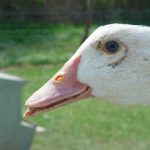Avian leucosis is a group of tumour diseases of chicken that has been known for a long time. It causes a variety of malignant or benign tumor lesions. The impact is mainly economic, with losses due to decreases in weight gain or egg production. Lymphoid leucosis is the most common form observed in the field, although myeloblastosis is being observed more and more frequently.
The disease agent and its pathogenicity
The etiological agent is a retrovirus of the Retroviridae family. It is a fragile virus that does not resist long in the external environment. It consists of a dense central nucleoid (2 RNA molecules associated with proteins), a 35-45 nm diameter viral capsid surrounded by an inner membrane and an outer shell. This organization is typical of the retrovirus serogroup C. The overall size of the viral particle is 80 to 120 nm in diameter. A viral reverse transcriptase allows the translation of viral RNA into proviral DNA that integrates into the genome of the host cell.
Retroviruses mutate easily. Variants appear frequently. Some have missing genes and depend on other viruses for replication, which facilitates genome exchanges between viruses.
Two major groups of leukosic retroviruses can be identified :
- Acute oncogenesis viruses, which cause leukaemia or solid tumours ; they have an oncogene and are genetically defective, they require another virus for their replication.
- Slow oncogenesis viruses, which do not carry oncogenes and induce viral transformation by activating a cellular oncogene by entering the host genome.
There are six serogroups (A, B, C, D, E, D, J). The most common is A, which causes lymphoid leucosis in general. The virus can multiply in all cells except gametes and neurons. The retrovirus will cause the transformation of a blood cell line or the uncontrolled multiplication of stem cells from the hematolymphopoietic lineage . Depending on the lineage mainly affected, we will have different diseases:
- Lymphoid lineage ⇒ Lymphoid leucosis
- Erythroid lineage ⇒ erythroblastosis
- Myeloid lineage ⇒ myeloblastosis
- Other lineages (myelocytomatosis, …)
The major neoplastic phenomenon depends on the infective dose of virus. In addition to this main neoplastic phenomenon, a viral strain often affects other cell types.
Erythroid, myeloid leucosis, myelocytomatosis, and other types of tumors are rapidly developing leucosis caused by viral strains containing oncogenes.
Lymphoid leucosis is a slowly developing leucosis, the virus involved has no oncogenes.
Finally, infection with a retrovirus can cause non-tumor forms.
There are 2 forms of leucotic viruses. There are exogenous retroviruses, transmitted by viral particles from one animal to another (the most common situation), and endogenous retroviruses, permanently included in the animal’s genome and not forming viral particles. Endogenous viruses are not or only slightly oncogenic, but can influence the host’s response to exogenous viruses.
Following infection, birds develop humoral immunity, with the production of neutralizing antibodies to limit viral multiplication, but without direct influence on tumor growth. There is no cross-protection between serogroups. Cell-mediated immune reactions are also involved, which have an effect on both the virus and neoplastic phenomena.
Some birds develop resistance to leucosis. There are 2 levels of resistance : resistance to viruses and resistance to tumors. Virus resistance is a phenotype with a well-characterized Mendelian transmission, but the mechanisms of transmission of infection resistance are still poorly understood.
Epidemiological data
Leucosis mainly affects chicken, but pheasant, partridge and quail can be infected.
Lymphoid leucosis is rarely found before 14 weeks of age because the incubation period is long : a bird contaminated between 1 and 14 days of age is at risk of developing lymhoid leucosis between 14 and 30 weeks of age, with an increased incidence when it reaches sexual maturity.
Erythroblastosis occurs at about 3-6 months of age.
Myeloblastosis affects adults, except at high doses where mortality can be observed 10 days after infection in chicks. It is rare.
Myelocytomatosis is mainly found in immature birds, but its incubation period varies greatly depending on the strain.
The prevalence of infection is currently rare.
In an infected flock, all birds are exposed to the virus at sexual maturity ; however, tumor development is uncommon. Immunosuppression caused by other diseases can increase the severity of retrovirus infection.
Transmission can be horizontal, through saliva and faeces ; it must be direct because the virus is quickly inactivated in an outdoor environment. This transmission is not very effective except during the neonatal period.
Vertical transmission is possible, congenital by infection of the embryo during its passage through the uterus and vagina, or genetic by inclusion of the virus in the gametes (in the case of endogenous retroviruses).
Congenital transmission ensures that infection is maintained from one generation to the next ; birds infected by this route constitute a reservoir from which contamination can occur through direct contact. Horizontal transmission is necessary to avoid the extinction of the infection.
Birds can be viremic (V+) or not (V-), HIV-positive (S+) or not (S-). V+ and S+ are often birds over 2 weeks old that can transmit the infection. V+ S- are congenitally or neonatally infected birds (less than 2 weeks old) that have become immunotolerant ; they are the most dangerous because they excrete the most. V- S+ are adults, often infected by direct contact, whose antibodies control the infection ; they can sometimes transmit the infection vertically. V- S- have never come into contact with the virus or are genetically resistant.
Clinical manifestations of the disease
Symptoms
They are very variable and not very specific. Bad ADG, delayed sexual maturity, poor egg production, anaemia, leg deformities can be observed. It’s a cachexia disease. Mortality is often low.
Lesions
- Non-neoplastic forms : immunosuppression, hepatitis, decline, myocarditis, hypothyroidism.
- Lymphoid leucosis : generally whitish nodular masses, especially in the liver, spleen, kidneys and Fabricius bursa. Pale crest, even cyanotic. Tumors are made up of aggregates of B lymphocytes.
- Erythroblastosis : cherry red viscera, enlarged, friable, friable bone marrow, anemia, coagulation defects, leukemia.
- Myeloblastosis : enlarged, granular, grey liver, spleen and kidneys, sometimes severe leukaemia, anemia, thrombocytopenia.
- Myelocytomatosis : whitish masses on the surface of the bones (costochondral junction, sternum, pelvis, head), hypertrophy of the viscera.
Solid tumors are sometimes found : nephroblastoma, hemangiomas - Osteopetrosis : this affects long bones symmetrically, especially tibiotarses and tarsometatarses, and causes their enlargement by abnormal deposition of bones in the cortex ; it can go as far as a complete disappearance of the medullar cavity.
The diagnosis
The autopsy lesions are quite suggestive.
Laboratory diagnosis
Histology allows the identification of the type of tumors. In the case of lymphoid leucosis, analysis of the lesions shows that they are composed of foci of large proliferating lymphoid cells, immature lymphoblasts.
Virology and serology can also be used.
Differential diagnosis
Marek’s disease, tuberculosis, coligranulomatosis
Disease prevention and control
Prevention
No treatment can limit the development of tumors.
Prevention consists in carrying out serological monitoring in order to create and maintain free flocks. The prevalence of A, B and J serogroups in breeding flocks has thus been drastically reduced or even eliminated.
Work is also being done to establish naturally resistant chicken lines.







